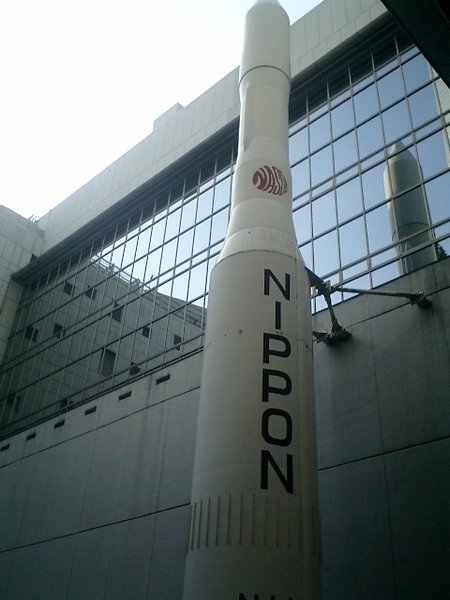N-I (rocket) on:
[Wikipedia]
[Google]
[Amazon]
 The N-I or N-1 was a derivative of the American
The N-I or N-1 was a derivative of the American
 The N-I or N-1 was a derivative of the American
The N-I or N-1 was a derivative of the American Thor-Delta
The Thor-Delta, also known as Delta DM-19 or just Delta was an early American expendable launch system used for 12 orbital launches in the early 1960s. A derivative of the Thor-Able, it was a member of the Thor family of rockets, and the first ...
rocket, produced under license in Japan. The N stood for "Nippon" (Japan). It used a Long Tank Thor first stage, a Mitsubishi Heavy Industries
is a Japanese Multinational corporation, multinational engineering, electrical equipment and electronics corporation headquartered in Tokyo, Japan. MHI is one of the core companies of the Mitsubishi Group and its automobile division is the prede ...
-designed LE-3 engine on the second stage, and three Castor SRMs. Seven were launched between 1975 and 1982, before it was replaced by the N-II. Six of the seven launches were successful, however on the fifth flight, there was recontact between the satellite and the third stage, which caused the satellite to fail.
On 29 February 1976, the second N-I conducted the only orbital launch, as of 17 February 2024, to occur on a leap day
A leap year (also known as an intercalary year or bissextile year) is a calendar year that contains an additional day (or, in the case of a lunisolar calendar, a month) compared to a common year. The 366th day (or 13th month) is added to kee ...
.
Launch history
Payload Descriptions
Engineering Test Satellite I "KIKU-1" (ETS-1)
ETS-1 was the first satellite launched by theNASDA
The , or NASDA, was a Japanese national space agency established on October 1, 1969 under the National Space Development Agency Law only for peaceful purposes. Based on the Space Development Program enacted by the Minister of Education, Culture ...
. It had the objective of acquiring information on N-series launch vehicles, orbit injection, and tracking and control. It ceased operations on 28 April 1982.
Ionosphere Sounding Satellite "UME" (ISS)
UME was Japan's first Ionosphere Sounding Satellite. It was used to monitor radio waves in the ionosphere and forecast conditions for shortwave communications. A power supply issue caused Ume to stop functioning one month after launch.Engineering Test Satellite II "KIKU-2" (ETS-2)
KIKU-2 was NASDA's first satellite launched to GEO. It was intended to gather data on geostationary satellite launch, tracking, control, orbit maintenance, and attitude control as well as carrying out experiments on communications equipment. KIKU-2 ceased operations on 10 December 1990, leaving GEO.Ionosphere Sounding Satellite "UME-2" (ISS-b)
UME-2 had similar goals to the original UME satellite, but was much more successful in carrying them out. While it was originally intended to gather data for only a year and a half, UME-2 ceased operations on 23 February 1983.Experimental Communications Satellites "Ayame/Ayame-2" (ECS/ECS-b)
Both ECS satellites were unsuccessful in completing their mission. During the first ECS launch, the third stage rocket collided with the satellite shortly after separation. During the ECS-2 launch, the satellite stopped transmitting shortly after separation. The satellites had the intention of conducting millimeter wave experiments. The JAXA website states that "we learned some valuable lessons on satellite separation technology and apogee engine from this experience".About Engineering Test Satellite III "KIKU-4" (ETS-III)
KIKU-4 was developed to acquire data on designing earth observation satellites with high power requirements. KIKU-4 completed testing of three-axis attitude control, deployable solar panels, movable heat control, and ion engine operation. On 8 April 1985, the satellite ran out of fuel and ceased operation.See also
* Comparison of orbital launchers families *Delta rocket
The Delta rocket family was a versatile range of American rocket-powered expendable launch systems that provided space launch capability in the United States from 1960 to 2024. Japan also launched license-built derivatives (N-I (rocket), N-I, N ...
* H-I
*H-II
The H-II (H2) rocket was a Japanese satellite launch system, which flew seven times between 1994 and 1999, with five successes. It was developed by NASDA in order to give Japan a capability to launch larger satellites in the 1990s. It was the fi ...
*H-IIA
H-IIA (H-2A) is an active expendable launch system operated by Mitsubishi Heavy Industries (MHI) for the Japan Aerospace Exploration Agency. These liquid fuel rockets have been used to launch satellites into geostationary orbit; lunar orbi ...
* N-II (rocket)
*PGM-17 Thor
The PGM-17A Thor was the first operative ballistic missile of the United States Air Force (USAF). It was named after the Thor, Norse god of thunder. It was deployed in the United Kingdom between 1959 and September 1963 as an intermediate-range b ...
References
{{Thor and Delta rockets Mitsubishi Heavy Industries space launch vehicles Thor (rocket family) Vehicles introduced in 1975 Japan–United States relations